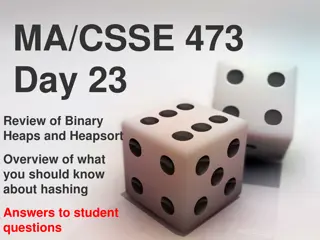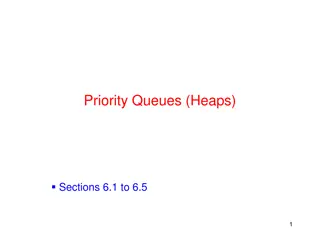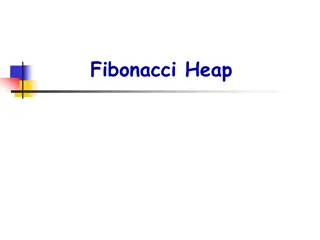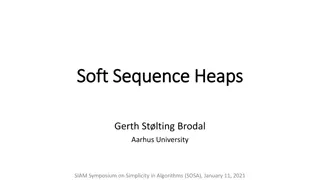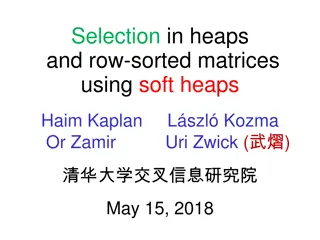
Binary Heaps and Priority Queues: Data Structures Analysis and Operations
Learn about binary heaps, priority queues, and efficient data structures for managing data items. Explore algorithms for insertion, deletion, and searching. Understand the properties and functions of binary min-heaps. Get insights on maintaining structure and heap properties during deleteMin operations.
Download Presentation

Please find below an Image/Link to download the presentation.
The content on the website is provided AS IS for your information and personal use only. It may not be sold, licensed, or shared on other websites without obtaining consent from the author. If you encounter any issues during the download, it is possible that the publisher has removed the file from their server.
You are allowed to download the files provided on this website for personal or commercial use, subject to the condition that they are used lawfully. All files are the property of their respective owners.
The content on the website is provided AS IS for your information and personal use only. It may not be sold, licensed, or shared on other websites without obtaining consent from the author.
E N D
Presentation Transcript
CSE 373: Data Structures and Algorithms Lecture 12: Binary Heaps Instructor: Lilian de Greef Quarter: Summer 2017
Announcements Midterm on Friday Practice midterms on course website Note that some may cover slightly different material Will start at 10:50, will end promptly at 11:50 (even if you re late), so be early Will have homework 3 grades back before midterm Reminder: course feedback session on Wednesday
Priority Queue ADT Meaning: A priority queue holds compare-able data Key property: deleteMin returns and deletes the item with the highest priority (can resolve ties arbitrarily) Operations: deleteMin insert isEmpty 2 6 15 23 12 18 insert deleteMin 7 45 3
Finding a good data structure Will show an efficient, non-obvious data structure for this ADT But first let s analyze some obvious ideas for n data items data insert algorithm / timedeleteMin algorithm / time unsorted array add at end search unsorted linked list add at front search search / shift move front sorted circular array put in right place remove at front sorted linked list put in right place leftmost binary search tree put in right place leftmost AVL tree
Our data structure A binary min-heap (or just binary heap or just heap) has: Structure property: Heap property: The priority of every (non-root) node is less important than the priority of its parent 10 10 20 80 5 18 40 60 85 99 3 7 50 700 So: Where is the highest-priority item? Where is the lowest priority? What is the height of a heap with n items?
deleteMin: Step #1 1 4 3 7 5 8 9 11 9 6 10
deleteMin: Step #2 (Keep Structure Property) Want to keep structure property 4 3 7 5 8 9 11 9 6 10
deleteMin: Step #3 Want to restore heap property 4 3 7 5 8 9 11 9 6
deleteMin: Step #3 (Restore Heap Property) Percolate down: Compare priority of item with its children If item has lower priority, swap with the most important child Repeat until both children have lower priority or we ve reached a leaf node ? 10 10 3 ? 3 4 3 4 4 8 7 5 8 9 7 5 8 9 7 5 10 9 11 9 6 11 9 6 11 9 6 What is the run time?
deleteMin: Run Time Analysis Run time is A heap is a So its height with n nodes is So run time of deleteMin is
insert: Step #1 2 1 4 3 7 5 8 9 11 9 6
insert: Step #2 2 1 4 3 7 5 8 9 11 9 6
insert: Step #2 (Restore Heap Property) Percolate up: Put new data in new location If higher priority than parent, swap with parent Repeat until parent is more important or reached root 2 1 1 1 ? 4 8 2 4 8 8 7 5 10 9 7 10 9 7 4 10 9 ? 2 ? 11 9 6 11 9 6 11 9 6 2 5 5 What is the running time?
Summary: basic idea for operations findMin: return root.data Overall strategy: 1. Preserve structure property 2. Restore heap property deleteMin: 1. answer = root.data 2. Move right-most node in last row to root to restore structure property 3. Percolate down to restore heap property insert: 1. Put new node in next position on bottom row to restore structure property 2. Percolate up to restore heap property
Binary Heap Operations O(logn) insert O(logn) deleteMinworst-case Very good constant factors If items arrive in random order, then insert is O(1) on average
Summary: Priority Queue ADT 2 6 15 23 Priority Queue ADT: insert comparable object, deleteMin 12 18 insert deleteMin 7 45 3 10 Binary heap data structure: Complete binary tree Each node has less important priority value than its parent 20 80 40 60 85 99 700 50 insert and deleteMin operations = O(height-of-tree)=O(logn) insert: put at new last position in tree and percolate-up deleteMin: remove root, put last element at root and percolate-down
Binary Trees Implemented with an Array Array From node i: A left child: i*2 right child: i*2+1 parent: i/2 B C F G D E (wasting index 0 is convenient for the index arithmetic) H I J K L 0 1 2 3 4 5 6 7 8 9 10 11 12 13
Judging the array implementation Pros: Non-data space: just index 0 and unused space on right In conventional tree representation, one edge per node (except for root), so n-1 wasted space (like linked lists) Array would waste more space if tree were not complete Multiplying and dividing by 2 is very fast (shift operations in hardware) Last used position is just index Cons: Same might-be-empty or might-get-full problems we saw with array-based stacks and queues (resize by doubling as necessary) Pros outweigh cons: min-heaps almost always use array implementation
Practice time! Starting with an empty array-based binary heap, which is the result after 1. insert (in this order): 16, 32, 4, 67, 105, 43, 2 2. deleteMin once 0 1 2 3 4 5 6 7 C) A) 4 15 32 43 67 105 4 32 16 43 105 67 0 1 2 3 4 5 6 7 0 1 2 3 4 5 6 7 B) D) 16 32 4 67 105 43 4 32 16 67 105 43 0 1 2 3 4 5 6 7 0 1 2 3 4 5 6 7
Semi-Pseudocode: insert into binary heap void insert(int val) { if(size==arr.length-1) resize(); size++; i=percolateUp(size,val); arr[i] = val; } int percolateUp(int hole, int val) { while(hole > 1 && val < arr[hole/2]) arr[hole] = arr[hole/2]; hole = hole / 2; } return hole; } 10 This pseudocode uses ints. In real use, you will have data nodes with priorities. 20 80 40 60 85 99 700 50 10 20 80 40 60 85 99 700 50 0 1 2 3 4 5 6 7 8 9 10 11 12 13
Semi-Pseudocode: deleteMin from binary heap int percolateDown(int hole, int val) { while(2*hole <= size) { left = 2*hole; right = left + 1; if(right > size || arr[left] < arr[right]) target = left; else target = right; if(arr[target] < val) { arr[hole] = arr[target]; hole = target; } else break; } return hole; } int deleteMin() { if(isEmpty()) throw ans = arr[1]; hole = percolateDown (1,arr[size]); arr[hole] = arr[size]; size--; return ans; } 10 20 80 40 60 85 99 700 50 10 20 80 40 60 85 99 700 50 0 1 2 3 4 5 6 7 8 9 10 11 12 13
Example 1. insert (in this order): 16, 32, 4, 67, 105, 43, 2 2. deleteMin once 0 1 2 3 4 5 6 7
Example 1. insert (in this order): 16, 32, 4, 67, 105, 43, 2 2. deleteMin once 0 1 2 3 4 5 6 7 2 32 4 16 67 105 43
Other operations decreaseKey: given pointer to object in priority queue (e.g., its array index), lower its priority value by p Change priority and percolate up increaseKey: given pointer to object in priority queue (e.g., its array index), raise its priority value by p Change priority and percolate down remove: given pointer to object in priority queue (e.g., its array index), remove it from the queue decreaseKey with p = , then deleteMin Running time for all these operations?
Build Heap Suppose you have n items to put in a new (empty) priority queue Call this operation buildHeap ninserts Only choice if ADT doesn t provide buildHeap explicitly Why would an ADT provide this unnecessary operation? Convenience Efficiency: an O(n) algorithm Common issue in ADT design: how many specialized operations
heapify(Floyds Method) 1. Use n items to make any complete tree you want That is, put them in array indices 1, ,n 2. Fix the heap-order property Bottom-up: percolate down starting at nodes one level up from leaves, work up toward the root
heapify(Floyds Method): Example 1. Use n items to make any complete tree you want 12 2. Fix the heap-order property from bottom-up 5 11 Which nodes break the heap-order property? Why work from the bottom-up to fix them? 3 10 2 9 - Why start at one level above the leaf nodes? 4 8 1 7 6 - Where do we start here?
heapify(Floyds Method): Example 12 5 11 3 10 2 9 4 8 1 7 6
heapify(Floyds Method): Example 12 5 11 3 1 2 9 4 8 10 7 6
heapify(Floyds Method): Example 12 3 2 5 10 6 9 4 8 1 7 11
heapify(Floyds Method): Example 2 3 6 5 10 11 9 4 8 1 7 12
heapify(Floyds Method) void buildHeap() { for(int i= size/2; i>0; i--) { val = arr[i]; hole = percolateDown(i, val); arr[hole] = val; } } it seems to work But is it right? Let s prove it restores the heap property Then let s prove its running time
Correctness void buildHeap() { for(i = size/2; i>0; i--) { val = arr[i]; hole = percolateDown(i,val); arr[hole] = val; } } Loop Invariant: For all j > i, arr[j] is higher priority than its children True initially: If j > size/2, then j is a leaf Otherwise its left child would be at position > size True after one more iteration: loop body and percolateDown make arr[i] higher priority than children without breaking the property for any descendants So after the loop finishes, all nodes are less than their children
Efficiency void buildHeap() { for(i = size/2; i>0; i--) { val = arr[i]; hole = percolateDown(i,val); arr[hole] = val; } } buildHeap is where n is size Easier argument: loop iterations Each iteration does one percolateDown, each is This is correct, but there is a more precise ( tighter ) analysis of the algorithm
Efficiency void buildHeap() { for(i = size/2; i>0; i--) { val = arr[i]; hole = percolateDown(i,val); arr[hole] = val; } } buildHeap is where n is size Better argument: size/2 total loop iterations: O(n) 1/2 the loop iterations percolateDown at most 1/4 the loop iterations percolateDown at most 1/8 the loop iterations percolateDown at most ((1/2) + (2/4) + (3/8) + (4/16) + ) < 2 (page 4 of Weiss) i = 2 2i i=1
Lessons from buildHeap Without providing buildHeap, clients can implement their own that runs in worst case By providing a specialized operation (with access to the internal data), we can do worst case Intuition: Most data is near a leaf, so better to percolate down Can analyze this algorithm for: Correctness: Non-trivial inductive proof using loop invariant Efficiency: First (easier) analysis proved it was O(nlogn) Tighter analysis shows same algorithm is O(n)
Other branching factors for Heaps d-heaps: have d children instead of 2 Makes heaps shallower Indices for 3-heap Index Children Indices 1 2 3 - Example: 3-heap Only difference: three children instead of 2 Still use an array with all positions from 1 heapSize 4 5
Wrapping up Heaps What are heaps a data structure for? What is it usually implemented with? Why? What are some example uses?







